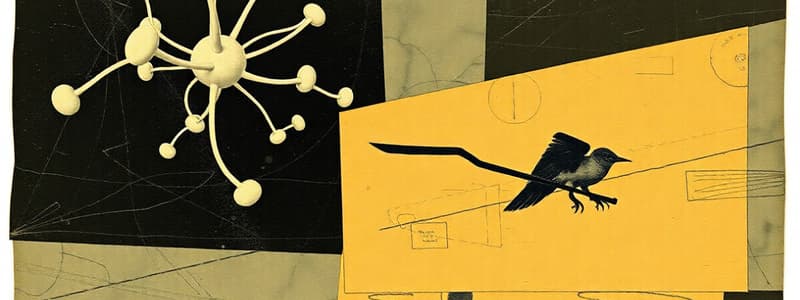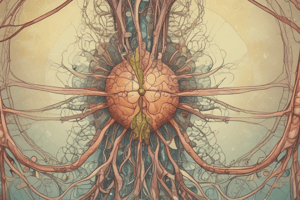Podcast
Questions and Answers
What is the predominant subtype of muscarinic receptors involved in cholinergic control of the heart?
What is the predominant subtype of muscarinic receptors involved in cholinergic control of the heart?
- M1 (correct)
- M3
- M5
- M2
Which pathway do the M1, M3, and M5 muscarinic receptors activate?
Which pathway do the M1, M3, and M5 muscarinic receptors activate?
- Gi pathway
- Gq-PLC pathway (correct)
- Adenylyl cyclase pathway
- cAMP pathway
What effect does acetylcholine have on heart rate?
What effect does acetylcholine have on heart rate?
- Decrease in heart rate (correct)
- Fluctuation in heart rate
- Increase in heart rate
- Stabilization of heart rate
Which muscarinic receptor subtype is primarily responsible for bronchoconstriction?
Which muscarinic receptor subtype is primarily responsible for bronchoconstriction?
What is one of the primary effects of acetylcholine on the vascular system?
What is one of the primary effects of acetylcholine on the vascular system?
How does acetylcholine affect conduction velocity in the AV node?
How does acetylcholine affect conduction velocity in the AV node?
Which muscarinic receptor subtype primarily inhibits adenylyl cyclase?
Which muscarinic receptor subtype primarily inhibits adenylyl cyclase?
What is the effect of acetylcholine on the force of cardiac contraction?
What is the effect of acetylcholine on the force of cardiac contraction?
What role do M2 muscarinic receptors play in smooth muscle secretory glands?
What role do M2 muscarinic receptors play in smooth muscle secretory glands?
What is methacholine primarily used for?
What is methacholine primarily used for?
Which drug is indicated for the treatment of glaucoma?
Which drug is indicated for the treatment of glaucoma?
What is a contraindication for using muscarinic receptor agonists?
What is a contraindication for using muscarinic receptor agonists?
What is the primary action of bethanechol?
What is the primary action of bethanechol?
Which muscarinic agonist is preferred for treating xerostomia with fewer side effects?
Which muscarinic agonist is preferred for treating xerostomia with fewer side effects?
What characterizes naturally occurring muscarinic antagonists?
What characterizes naturally occurring muscarinic antagonists?
Which option is NOT a function of pilocarpine?
Which option is NOT a function of pilocarpine?
Which muscarinic agonist can be used to ease swallowing in patients after head and neck radiation?
Which muscarinic agonist can be used to ease swallowing in patients after head and neck radiation?
What is a common side effect of muscarinic receptor agonists?
What is a common side effect of muscarinic receptor agonists?
Which drug is specifically indicated for the treatment of urinary retention?
Which drug is specifically indicated for the treatment of urinary retention?
What is a prominent effect of Scopolamine at therapeutic doses?
What is a prominent effect of Scopolamine at therapeutic doses?
Which muscarinic antagonist is used exclusively for respiratory problems?
Which muscarinic antagonist is used exclusively for respiratory problems?
Which of the following side effects is associated with the use of muscarinic antagonists?
Which of the following side effects is associated with the use of muscarinic antagonists?
What is a therapeutic use of atropine in the cardiovascular system?
What is a therapeutic use of atropine in the cardiovascular system?
Which statement about quaternary antagonists is true?
Which statement about quaternary antagonists is true?
What is the dominant cardiovascular response to atropine administration?
What is the dominant cardiovascular response to atropine administration?
What condition is not treated using muscarinic antagonists?
What condition is not treated using muscarinic antagonists?
Which muscarinic receptor does atropine primarily block to slow heart rate at clinical doses?
Which muscarinic receptor does atropine primarily block to slow heart rate at clinical doses?
Which muscarinic receptor subtype primarily mediates detrusor muscle contraction in the bladder?
Which muscarinic receptor subtype primarily mediates detrusor muscle contraction in the bladder?
How does atropine affect bronchoconstriction?
How does atropine affect bronchoconstriction?
What effect do muscarinic receptor agonists have on the gastrointestinal tract?
What effect do muscarinic receptor agonists have on the gastrointestinal tract?
What is one of the effects of atropine on the eyes?
What is one of the effects of atropine on the eyes?
Which choline ester is known to be resistant to hydrolysis by cholinesterases?
Which choline ester is known to be resistant to hydrolysis by cholinesterases?
What happens to gastric secretions when atropine is administered?
What happens to gastric secretions when atropine is administered?
Which statement about the absorption of muscarinic receptor agonists is correct?
Which statement about the absorption of muscarinic receptor agonists is correct?
In the eye, what response is caused by muscarinic receptor activation?
In the eye, what response is caused by muscarinic receptor activation?
What effect does atropine have on salivary secretion?
What effect does atropine have on salivary secretion?
What is the therapeutic use of muscarinic agonists in treating xerostomia?
What is the therapeutic use of muscarinic agonists in treating xerostomia?
What is one consequence of atropine-induced cycloplegia?
What is one consequence of atropine-induced cycloplegia?
Which hormone is NOT known to mediate gastric secretions in response to atropine?
Which hormone is NOT known to mediate gastric secretions in response to atropine?
What is the primary pharmacological action of muscarine?
What is the primary pharmacological action of muscarine?
Which of the following is a function of M2 receptors in the urinary tract?
Which of the following is a function of M2 receptors in the urinary tract?
How does larger doses of atropine affect the heart rate?
How does larger doses of atropine affect the heart rate?
What is the main therapeutic consideration when using atropine with respiratory disease patients?
What is the main therapeutic consideration when using atropine with respiratory disease patients?
Which of the following cholinergic agonists is a partial agonist at muscarinic receptors?
Which of the following cholinergic agonists is a partial agonist at muscarinic receptors?
Muscarinic agonists crossing the blood-brain barrier can lead to which of the following effects?
Muscarinic agonists crossing the blood-brain barrier can lead to which of the following effects?
Flashcards are hidden until you start studying
Study Notes
Muscarinic Receptors
- Found in the peripheral nervous system (PNS) on autonomic effector cells innervated by postganglionic parasympathetic nerves
- Found in the central nervous system (CNS) in the hippocampus, cortex, and thalamus
- Muscarinic agonists mimic the effects of acetylcholine (ACh) at these sites and are typically longer-acting
- All are G protein-coupled receptors (GPCRs)
Muscarinic Receptor Subtypes
- M1, M3, and M5: Activate the Gq-PLC pathway, causing hydrolysis of polyphosphoinositides and mobilization of intracellular Ca2+
- M2 and M4: Inhibit adenylyl cyclase and regulate specific ion channels via coupling to the pertussis toxin-sensitive G proteins (Gi and Go)
Pharmacological Effects of Acetylcholine
Cardiovascular System
- Vasodilation: Stimulates muscarinic receptors (primarily M3) on vascular endothelial cells, producing nitric oxide (NO) which relaxes vascular smooth muscle
- Decrease in heart rate: Negative chronotropic effect by decreasing the rate of spontaneous depolarization, delaying the attainment of threshold potential
- Decrease in conduction velocity in the AV node: Negative dromotropic effect by increasing the refractory period (inhibits Ca2+ channel opening)
- Decrease in the force of cardiac contraction: Negative inotropic effect by hyperpolarizing the atria and decreasing action potential (increasing K+ channel opening), and inhibiting cAMP formation and release of norepinephrine (NE)
Respiratory Tract
- Bronchoconstriction
- Increased tracheobronchial secretion
- Stimulation of the chemoreceptors of the carotid and aortic bodies
- Mediated by M3 muscarinic receptors on bronchial and tracheal smooth muscle
Urinary Tract
- Detrusor muscle (bladder) contraction: Primarily by M3 receptors, with some contribution from M2 receptors
- Increased voiding pressure
- Ureteral peristalsis
Gastrointestinal Tract
- Increased tone and amplitude of contractions
- Secretory activity of stomach and intestine
- Primarily mediated by M3 receptors, with some contribution from M2 receptors
Other Effects
- Lacrimal, nasopharyngeal, salivary, and sweat glands: Increased secretions via M3 receptors
- Eye: Miosis (pupillary sphincter contraction) and accommodation for near vision (ciliary muscle contraction)
- Central nervous system: Muscarinic agonists crossing the blood-brain barrier (BBB) can cause arousal or activation responses
Muscarinic Receptor Agonists
- Choline Esters: Methacholine, carbachol, and betanechol
- Cholinomimetic Alkaloids: Muscarine, arecoline, and pilocarpine
ADME of Receptor Agonists:
- Quaternary Amines: Poorly absorbed, do not cross the BBB, resistant to hydrolysis, short half-life (renal elimination)
- Tertiary Amines: Readily absorbed, cross the BBB, examples include arecoline and pilocarpine
Therapeutic Uses of Muscarinic Agonists
- Treatment of urinary bladder disorders
- Treatment of xerostomia (dry mouth)
- Diagnosis of bronchial hyperreactivity
Muscarinic Receptor Antagonists
- Naturally occurring alkaloids: Atropine and scopolamine
- Semisynthetic derivatives: Differ in disposition and duration of action
- Synthetic derivatives: Limited selectivity for specific receptor subtypes
Pharmacological Effects of Atropine
Cardiovascular System
- Tachycardia: Blocks M1 receptors on the SA node, inhibiting ACh release and leading to tachycardia.
- Larger doses: Can block M2 receptors on the SA node, further inhibiting parasympathetic activity
Respiratory System
- Inhibits bronchoconstriction: Can block bronchoconstriction caused by histamine, bradykinin, and eicosanoids
- Stops secretions: Dries mucus membranes of the respiratory tract
Eyes
- Mydriasis (pupil dilation) and Cycloplegia (paralysis of accommodation)
- Photophobia: Sensitivity to light
- Blurred vision: Lens is fixed for far vision, near objects are blurred
- Smaller appearance of objects: Normal pupillary reflex and convergence is abolished
Gastrointestinal Tract
- Incompletely inhibits GI responses to vagal stimulation: GI tract has other non-cholinergic synapses and plexuses
- Reduced gastric secretions: Gastric secretions are also mediated by gastrin-releasing peptides and other hormones (gastrin, histamine)
- Reduced salivary secretions: Can completely abolish watery secretion, making swallowing hard
Sweat Glands and Temperature
- Inhibits sweat gland activity: Leads to hot and dry skin
Central Nervous System
- Atropine: Minimal effects at therapeutic doses, toxic doses lead to restlessness, disorientation, and in larger doses, depression, circulatory collapse, respiratory failure, paralysis, and coma
- Scopolamine: Prominent effects including drowsiness, amnesia, fatigue, dreamless sleep, decreased REM sleep
- Anti-motion sickness: Effective by blocking neural pathways in the vestibular apparatus of the inner ear
ADME of Muscarinic Antagonists
- Tertiary antagonists: Belladonna alkaloids, synthetic and semisynthetic derivatives, rapid absorption from GIT, limited skin absorption
- Quaternary antagonists: Limited systemic absorption, less readily penetrate the eye, lack central effects
Therapeutic Effects of Muscarinic Antagonists
- Respiratory Tract: Ipratropium, tiotropium, aclidinium, and umeclidinium are used for respiratory problems like COPD
- Genitourinary Tract: Treat overactive bladder, lower intravesicular pressure, reduce frequency of contractions
- Gastrointestinal Tract: Treat diarrhea, once used for peptic ulcers
- Eye: Topical administration for mydriasis (examining retina and optic disc)
- Cardiovascular System: Atropine for excessive vagal tone (sinus bradycardia)
- Central Nervous System: Scopolamine for motion sickness
- Anesthesia: Atropine or glycopyrrolate block parasympathomimetic effects of neostigmine
Studying That Suits You
Use AI to generate personalized quizzes and flashcards to suit your learning preferences.




